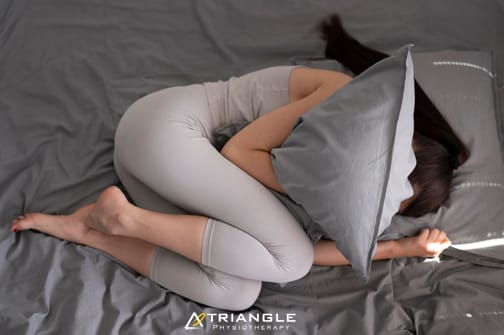Vaginismus is a condition often misunderstood and sometimes left undiagnosed due to lack of awareness or stigma. Lets demystify vaginismus by addressing the most frequently asked questions, including symptoms, causes, diagnosis, and effective treatments. Whether you’re seeking help for yourself or someone you know, understanding vaginismus is the first step toward finding relief and support. The pelvic health physiotherapists at Triangle Physiotherapy can help you overcome this condition and regain your quality of life.
1. What Is Vaginismus?
Vaginismus is a condition where involuntary muscle contractions occur around the vaginal opening, making penetration painful or even impossible. This muscle response can be triggered by physical or psychological factors and often interferes with intimate activities, tampon use, and even gynecological exams.
2. What Are the Symptoms?
- Pain or discomfort during penetration
- Burning, stinging, or tightness in the pelvic area
- Difficulty with vaginal penetration, such as tampon use or gynecological exams
- Anticipation of pain before intimacy due to past experiences
3. What Causes Vaginismus?
Previous painful intercourse or other experiences that create a conditioned response in the muscles
- Anxiety or fear of pain
- Trauma or past experiences, such as sexual abuse
- Certain medical conditions, infections, or hormonal imbalances
- Lack of awareness or knowledge about the condition
4. How common is it?
Although exact prevalence is hard to determine, vaginismus is not uncommon. Many people don’t seek help due to embarrassment or misconceptions, but it is estimated that a significant number of people with vaginas experience some form of pelvic pain or vaginismus at some point.
5. What is the difference between primary and secondary Vaginismus?
Primary Vaginismus
• sexually inexperienced
• penetration problem apparent at first attempt
• sexual penetration may seem physically impossible
• unconsummated couples
• sometimes difficulty inserting tampons/undergoing pelvic exam
Secondary Vaginismus
• sexually experienced
• previously normal sex life
• ongoing vaginal tightness, discomfort, pain with intercourse
• usually precipitated by medical condition, menopause, traumatic event, childbirth, surgery, etc.
• sometimes difficulty with pelvic exam
6. Is there a treatment for Vaginismus?
Vaginismus can be a challenging condition to manage. While exercises and stretches done at home are helpful, additional support may be necessary.
That’s where pelvic floor physiotherapy comes in.
A pelvic health physiotherapist can help you to:
- Offer personalized guidance on pelvic floor exercises for managing vaginismus.
- Identify any pelvic floor dysfunctions.
- Learn specific exercises to strengthen the pelvic floor muscles.
- Practice targeted stretches to relax essential areas.
- Address symptoms such as incontinence, constipation, pelvic pain, prolapse, and others.

While vaginismus can be a challenging condition, there is hope and help available. Seeking support from qualified professionals and understanding treatment options can lead to meaningful improvement. Remember, vaginismus is a common issue, and addressing it openly is the first step toward reclaiming comfort and confidence. Book an appointment with one of our pelvic health physiotherapists in Mississauga, Oakville or Toronto to get help today!
Here are links to studies and articles that discuss the prevalence of vaginismus and the effectiveness of pelvic floor therapy as a treatment:
- Reissing et al.’s study on pelvic floor physical therapy in lifelong vaginismus, which provides insights into patient experiences and therapy outcomes, including reductions in pain and improved quality of life. This research suggests that pelvic floor therapy can be effective, particularly with a tailored approach involving manual techniques and education. You can access it hereRead by QxMD.
- For further context on the prevalence of vaginismus and other sexual dysfunctions, look into studies by Miller et al., which highlight pelvic floor disorders in U.S. women and treatment options.
Pregnancy is an incredible journey, but it can also bring a variety of physical changes and challenges. One of the best ways to support your body during this time is by seeing a pelvic health physiotherapist.
The good news is that the pelvic health physiotherapists at Triangle Physiotherapy are experienced and trained to help you to smoothly navigate your pregnancy journey.
Here are eight compelling reasons to consider this specialized care throughout your pregnancy.
1. Alleviate Discomfort and Pain

Pregnancy can lead to discomfort and pain in various areas, particularly the lower back, hips, and pelvis. A pelvic health physiotherapist can assess your posture, movement patterns, and muscle imbalances. They can provide targeted exercises and techniques to relieve pain, helping you feel more comfortable as your body changes.
2. Improve Core and Pelvic Floor Strength
Strong core and pelvic floor muscles are essential during pregnancy. A pelvic health physiotherapist can guide you through safe exercises that strengthen these areas, preparing your body for the physical demands of labor and delivery. This foundation can also help reduce the risk of complications during childbirth.
3. Enhance Posture and Body Mechanics
As your pregnancy progresses, your center of gravity shifts, often leading to changes in posture. Poor posture can contribute to discomfort and pain. A pelvic health physiotherapist can teach you proper body mechanics and alignment strategies, helping you maintain good posture throughout your pregnancy and beyond.
4. Manage Incontinence Issues
Many pregnant women experience urinary incontinence due to the added pressure on the bladder and hormonal changes. A pelvic health physiotherapist specializes in pelvic floor dysfunction and can provide exercises to strengthen the pelvic floor, helping to manage and reduce incontinence issues during and after pregnancy.
5. Prepare for Labor and Delivery
A pelvic health physiotherapist can help you prepare your body for labor and delivery through specific exercises and techniques. They can teach you breathing strategies, positions for labor, and relaxation techniques, empowering you with tools to facilitate a smoother birthing experience.
6. Support Postpartum Recovery
While the focus is often on pregnancy, the postpartum period is equally important. A pelvic health physiotherapist can help you transition back to your pre-pregnancy activities by addressing any lingering pain, pelvic floor dysfunction, or core weakness. Early intervention can lead to better recovery and long-term health.
7. Educate on Body Changes
Understanding the physical changes your body undergoes during pregnancy can be incredibly empowering. A pelvic health physiotherapist provides education on what to expect, including changes to your pelvic floor and core muscles. This knowledge can help alleviate fears and build confidence as you navigate your pregnancy and postpartum recovery.
8. Personalized Care and Support
Every pregnancy is unique, and a pelvic health physiotherapist offers personalized care tailored to your specific needs. They take the time to understand your individual concerns, lifestyle, and goals, ensuring that you receive the most effective treatment. This supportive environment fosters trust and encourages open communication about any issues you may encounter.
Book Your Appointment Today!
Seeing a pelvic health physiotherapist is a very important part of your pregnancy journey. Book your appointment as soon as you have confirmation of your pregnancy to make sure you have a supportive healthcare practitioner alongside you to guide you through this new and exciting phase in your life.
Triangle Physiotherapy has eight locations in the GTA offering pelvic health physiotherapy. Call us today!
Ref: https://pelvichealthsolutions.ca/knowledge-base/pregnancy
Understanding the Pelvic Floor and Bladder Health
The pelvic floor consists of a group of muscles that support the bladder, bowel, and uterus (in women). These muscles are responsible for controlling urination, bowel movements, and sexual function. When weakened, common issues such as incontinence, pelvic organ prolapse, and sexual dysfunction can arise. Understanding the role of these muscles is the first step toward strengthening them.
Strengthening you pelvic floor can lead to a stress-free lifestyle. Schedule an appointment with one of the pelvic health physiotherapists at Triangle Physiotherapy.
Key functions of the Pelvic Floor:
- Support of pelvic organs
- Control of bladder and bowel movements
- Sexual health and satisfaction
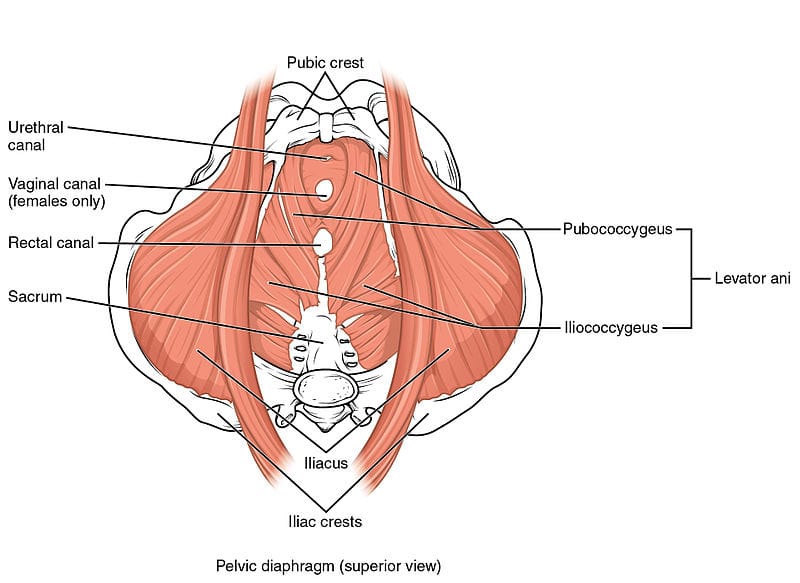
Benefits of Strengthening the Pelvic Floor
By keeping your pelvic floor muscles strong, you can experience several benefits beyond preventing common issues like incontinence. Some of these include:
- Enhanced bladder control: Strong muscles prevent leakage during activities like sneezing, laughing, or exercising.
- Better posture: The pelvic floor is connected to core muscles, and strengthening it can improve your overall posture.
- Improved sexual function: Strengthening the pelvic muscles can lead to better sexual sensations and enhanced satisfaction.
- Postpartum recovery: New mothers can benefit from a stronger pelvic floor to regain muscle strength after childbirth.
Lifestyle Changes for Pelvic Health

Incorporating small but impactful changes in your daily routine can go a long way in improving pelvic floor and bladder health. Here are a few simple yet effective lifestyle adjustments:
- Stay hydrated but mindful of fluids: Drink plenty of water throughout the day, but reduce intake of caffeinated or carbonated drinks that can irritate the bladder.
- Maintain a healthy weight: Excess weight puts pressure on the pelvic floor, weakening it over time. Maintaining a healthy BMI can reduce strain.
- Eat a fiber-rich diet: Consuming enough fiber prevents constipation, which can stress the pelvic floor.
- Quit smoking: Chronic coughing caused by smoking weakens the pelvic floor muscles over time.
Strengthening your pelvic floor and bladder is a journey that requires consistency and dedication. By incorporating simple exercises, making mindful lifestyle changes, and considering professional or holistic support, you can enjoy better control, confidence, and overall well-being. Remember, prevention is always better than cure, so taking steps to support your pelvic health now will benefit you in the long run.
This lifestyle guide offers a comprehensive approach to strengthening your pelvic floor and bladder. By following these tips and making small adjustments, you’ll be well on your way to a healthier and stronger pelvic floor.
Contact us today to book an appointment with one of our pelvic health physiotherapists at either of our 8 locations and get your recovery journey started.
Pregnancy is a beautiful journey, but it can come with its fair share of discomforts, one of which is pelvic pain. For many expectant mothers, pelvic pain is a common issue that can impact their daily lives. Understanding the causes and exploring effective treatments can help manage this discomfort and ensure a smoother pregnancy experience. At Triangle Physiotherapy, our trained and experienced pelvic health physiotherapists are committed to helping you with your pelvic pain so that you can get back your quality of life and do the things you love.

Here’s a detailed look at the causes of pelvic pain during pregnancy and the available treatment options.
Causes of Pelvic Pain During Pregnancy
1. Hormonal Changes
During pregnancy, the body undergoes significant hormonal changes, particularly with the increase in relaxin—a hormone that helps the pelvis become more flexible in preparation for childbirth. While this is necessary for delivery, it can also lead to joint instability and pelvic pain as the ligaments and joints become looser and less stable.
2. Growing Uterus
As the pregnancy progresses, the growing uterus exerts pressure on the pelvic region. This pressure can cause discomfort and pain, especially as the uterus expands and shifts its position. The added weight can also put strain on the pelvic joints and muscles.
3. Pelvic Girdle Pain (PGP)
Pelvic Girdle Pain, also known as Symphysis Pubis Dysfunction (SPD), is a condition where the pelvic joints become painful and unstable. This can occur when the ligaments that support the pelvic bones become too relaxed and unable to support the growing weight. PGP can cause pain in the pelvic region, hips, and lower back.
4. Round Ligament Pain
Round ligament pain is another common cause of pelvic discomfort during pregnancy. The round ligaments, which support the uterus, stretch as the uterus grows. This stretching can cause sharp or aching pain in the lower abdomen or groin area, especially with sudden movements.
5. Previous Injuries or Conditions
Women with a history of pelvic injuries or pre-existing conditions like endometriosis or fibroids may experience exacerbated pelvic pain during pregnancy. The added physical changes can aggravate these pre-existing issues.
Schedule an appointment with one of the pelvic health physiotherapists at Triangle Physiotherapy and get your recovery journey started.
Prevention
Preventing pelvic pain during pregnancy involves a combination of lifestyle adjustments and self-care practices:
- Exercise Regularly: Engage in low-impact exercises like walking, swimming, or prenatal yoga to strengthen the muscles around the pelvis and improve flexibility.
- Maintain Good Posture: Pay attention to your posture, especially when sitting or standing for extended periods. Proper posture can alleviate unnecessary strain on the pelvic region.
- Use Supportive Gear: Consider using a maternity support belt or pelvic support belt to help stabilize the pelvis and reduce pain.
- Avoid High-Risk Movements: Try to avoid activities that involve sudden movements or heavy lifting, which can exacerbate pelvic pain.
Progressive Resistance
Progressive resistance training involves gradually increasing the intensity of exercises to build strength and stability. For pregnant women experiencing pelvic pain, this approach can be adapted to:
- Strengthen Core Muscles: Exercises that target the core, such as modified planks or gentle pelvic tilts, can help support the pelvic region and reduce pain.
- Strengthen Pelvic Floor Muscles: Kegel exercises can help strengthen the pelvic floor muscles, providing better support to the pelvic organs and reducing pain.
Neuromuscular Exercises
Neuromuscular exercises focus on improving coordination and muscle control, which can be beneficial for managing pelvic pain:
- Balance Training: Exercises that enhance balance and stability, such as gentle balance exercises on a stability ball, can help reduce the risk of falls and support the pelvic region.
- Proprioceptive Exercises: Activities that improve body awareness and spatial orientation can help in managing pelvic discomfort and improving overall function.
Mobility Exercises
Mobility exercises aim to enhance the range of motion and flexibility of the pelvic joints and surrounding muscles:
- Hip Flexor Stretches: Gentle stretching of the hip flexors can help alleviate tension and discomfort in the pelvic area.
- Pelvic Rocking: Performing gentle pelvic rocking exercises can help relieve pressure on the pelvis and improve comfort.
Safety Tips
Consult a Healthcare Provider: Always consult with your healthcare provider before starting any new exercise or treatment regimen to ensure it is safe for your specific situation.
- Listen to Your Body: Pay attention to your body’s signals and avoid pushing through pain. Modify or stop activities that exacerbate discomfort.
- Seek Professional Help: If pelvic pain becomes severe or persistent, consider seeking help from a physiotherapist who specializes in prenatal care.
Pelvic pain during pregnancy can be challenging, but understanding its causes and exploring effective treatments can provide significant relief. By incorporating preventative measures, progressive resistance training, neuromuscular exercises, and mobility exercises, expectant mothers can manage pelvic pain more effectively. Always prioritize safety and consult with healthcare professionals to tailor an approach that suits your individual needs. With the right care and support, you can navigate the journey of pregnancy with greater comfort and ease.
Menopause brings about numerous changes in a woman’s body, and one of the more common, yet rarely discussed, issues is painful sex. This discomfort can be distressing and have a significant impact on your intimate relationships and quality of life. However, many don’t realize that a key factor in this pain could be pelvic floor health.
In this post, we’ll explore how menopause affects your pelvic floor, why it can lead to painful sex, and what can be done to manage and alleviate this condition. Let’s break it down.
1. Understanding Menopause and Vaginal Changes
Menopause, typically occurring between ages 45 and 55, is marked by the natural decline in estrogen levels. This hormone is essential for maintaining the health and elasticity of your vaginal tissue. When estrogen production decreases, the vagina can become:
- Drier (vaginal atrophy or dryness)
- Thinner and more fragile
- Less elastic
These changes contribute to vaginal discomfort, especially during intercourse, and are a common cause of pain during sex for women in menopause.
2. The Role of the Pelvic Floor in Sexual Health
Your pelvic floor muscles play a crucial role in sexual function. These muscles support the pelvic organs, including the bladder, uterus, and rectum, and also control vaginal tightness and relaxation during sex.
When pelvic floor muscles are functioning properly, they:
- Help maintain vaginal tone
- Support lubrication and arousal
- Allow comfortable contraction and relaxation during intercourse
However, during menopause, the pelvic floor muscles may weaken or become overly tight (hypertonic), both of which can contribute to pain during sex. In fact, pelvic floor dysfunction is one of the leading causes of dyspareunia (painful sex) in menopausal women.
3. How Menopause Affects the Pelvic Floor
As estrogen levels drop, not only does vaginal tissue change, but the pelvic floor muscles also lose elasticity and strength. There are two main types of pelvic floor dysfunction that can result from menopause:
- Weak Pelvic Floor: Weakened muscles can result in less support for the pelvic organs, which may contribute to conditions like pelvic organ prolapse. This can lead to discomfort during sex.
- Tight Pelvic Floor: Some women develop tight or overactive pelvic floor muscles (hypertonicity), which can create tension and pain during penetration.
These issues, combined with vaginal dryness, can make intercourse uncomfortable or even painful.
4. Managing Painful Sex: The Role of Pelvic Floor Physiotherapy
The good news is that pelvic floor physiotherapy can play a significant role in managing and reducing pain during sex, particularly for women going through menopause.

Here’s how it works:
Pelvic Floor Muscle Training
For women with weakened pelvic floor muscles, physiotherapists may recommend exercises such as Kegels to strengthen the muscles. Strengthening exercises can improve vaginal tone, enhance sexual function, and reduce discomfort during intercourse.
Relaxation Techniques and Biofeedback
For those experiencing tight or overactive pelvic floor muscles, relaxation techniques are key. Physiotherapists can guide you through:
- Stretching exercises to release tension in the pelvic floor
- Breathing exercises to promote muscle relaxation
- Biofeedback to help you learn how to consciously relax your pelvic floor during sex
Vaginal Dilators

In some cases, physiotherapists may recommend vaginal dilators to help gently stretch and relax the vaginal muscles. This can be particularly helpful for women experiencing severe pain with penetration.
5. Additional Tips to Alleviate Painful Sex
In addition to physiotherapy, there are a few lifestyle adjustments and treatments that can help alleviate painful sex during menopause:
- Lubricants: Using a water-based lubricant can ease vaginal dryness and reduce friction during intercourse.
- Moisturizers: Regular use of vaginal moisturizers can help maintain hydration and prevent tissue dryness.
- Hormone Therapy: Consult with your doctor about localized estrogen treatments, such as creams, to restore vaginal tissue health.
- Open Communication: Talk to your partner about your pain and work together to find positions and techniques that minimize discomfort.
6. When to Seek Help
It’s important to remember that painful sex during menopause is not something you have to live with. If sex becomes uncomfortable or painful, seeking the help of a pelvic health physiotherapist can make a big difference. They will conduct a thorough assessment, address the underlying pelvic floor issues, and create a personalized treatment plan to restore your comfort and confidence in intimacy.
Painful sex during menopause is a common yet manageable issue. The changes in hormone levels can affect your vaginal health and pelvic floor, leading to discomfort during intercourse. However, pelvic floor physiotherapy can offer effective solutions, whether through strengthening, relaxation techniques, or other therapeutic methods.
By addressing these changes head-on and seeking appropriate treatment, you can enjoy pain-free and fulfilling intimacy throughout your menopausal years.
Do you have questions about how your pelvic floor may be contributing to painful sex? Contact us today to learn more about how pelvic health physiotherapy can help you regain comfort and confidence in your body.
Our pelvic health physiotherapists in Mississauga can help you regain your quality of life, menopause or not!
Pelvic pain can be a challenging and often misunderstood condition. It can significantly impact your quality of life, making it essential to understand your treatment options and management strategies. In this Q&A guide, we’ll explore the common questions surrounding pelvic pain and provide insights into how pelvic health physiotherapy can help.
What is pelvic pain, and what are its common causes?
Pelvic pain refers to discomfort or pain experienced in the lower abdomen, pelvis, or perineum. It can be acute (short-term) or chronic (lasting six months or more). The causes of pelvic pain are diverse and can include:
- Muscle dysfunction: Tight or weak pelvic floor muscles can lead to pain.
- Nerve conditions: Issues like pudendal neuralgia can cause significant discomfort.
- Gynecological conditions: Endometriosis, ovarian cysts, and uterine fibroids are common culprits.
- Urological issues: Interstitial cystitis or urinary tract infections (UTIs) can cause pelvic pain.
- Digestive disorders: Conditions like irritable bowel syndrome (IBS) and inflammatory bowel disease (IBD) may contribute to pain.
- Pregnancy and Childbirth
Understanding the underlying cause of your pelvic pain is crucial in determining the most effective treatment.
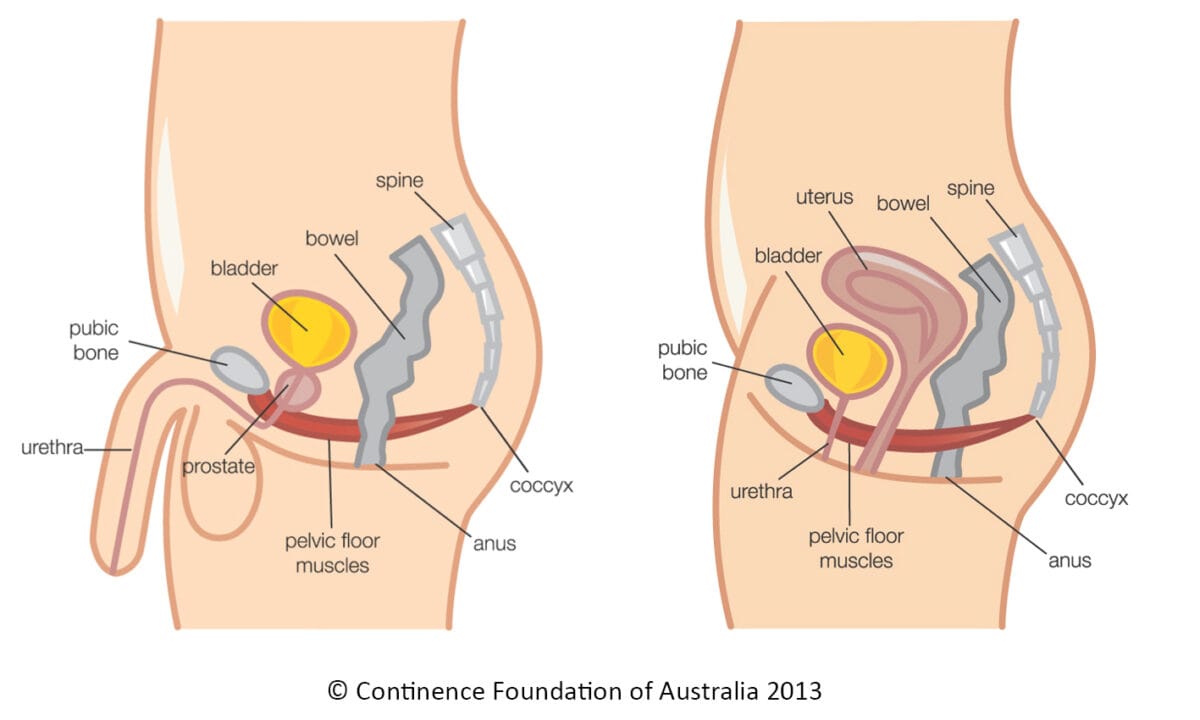
How can pelvic health physiotherapy help in managing pelvic pain?
Pelvic health physiotherapy is a specialized area of physiotherapy focused on the muscles, joints, and tissues of the pelvis. Here’s how it can help:
- Assessment and diagnosis: A pelvic health physiotherapist will conduct a thorough assessment to identify the root cause of your pain, including muscle strength, flexibility, and posture analysis.
- Manual therapy: Techniques such as myofascial release, trigger point therapy, and soft tissue mobilization can help alleviate pain by addressing muscle tension and improving circulation.
- Pelvic floor exercises: Tailored exercises can strengthen or relax pelvic floor muscles, depending on the nature of your pain.
- Education and lifestyle modifications: Understanding how daily activities, posture, and stress contribute to your pain can empower you to make changes that reduce discomfort.
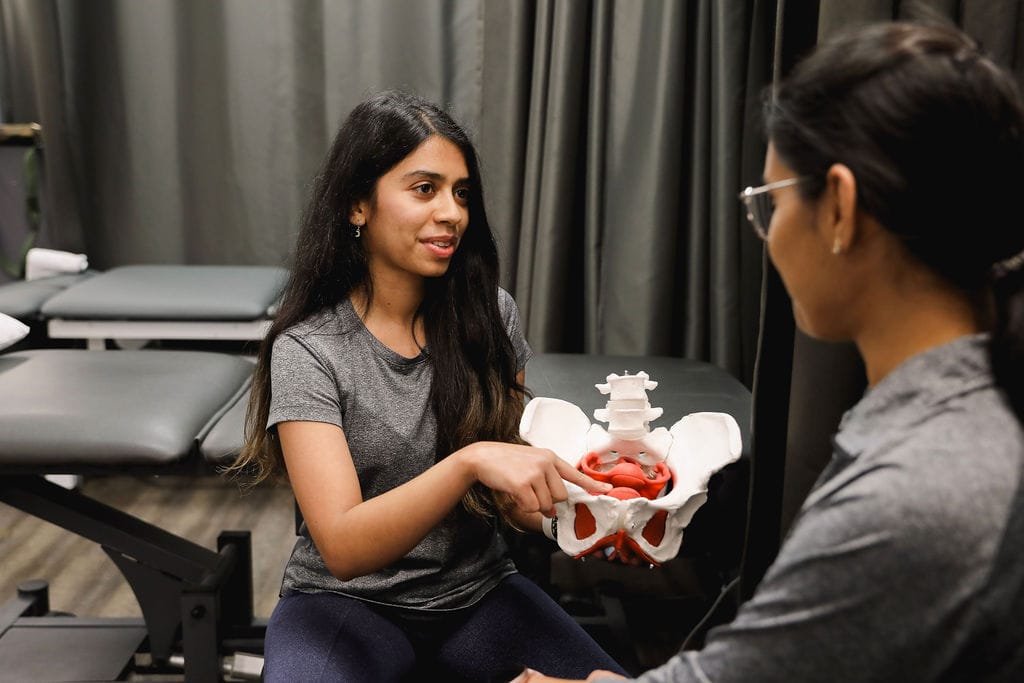
- Biofeedback and relaxation techniques: These can help in retraining your pelvic muscles to function properly without causing pain.
What are the common treatment options for pelvic pain?
Treatment for pelvic pain varies based on its underlying cause but typically includes a combination of the following:
- Medications: Anti-inflammatory drugs, muscle relaxants, and nerve pain medications can provide relief.
- Physiotherapy: Targeted exercises and manual therapies can improve muscle function and reduce pain.
- Injections: Corticosteroid or anesthetic injections may be used to manage pain in specific areas.
- Surgical intervention: In some cases, surgery may be necessary to address structural issues or remove sources of pain, such as endometriosis lesions.
- Alternative therapies: Acupuncture, massage, and yoga can complement traditional treatments by promoting relaxation and reducing stress, which may exacerbate pain.
Your pelvic health physiotherapist will work with you to develop a personalized treatment plan that addresses your specific needs.
How long does it take to see results from pelvic health physiotherapy?
The timeline for seeing results can vary depending on the severity and duration of your pelvic pain, as well as your commitment to the treatment plan. Generally, patients may start noticing improvements within a few weeks of consistent therapy. However, chronic conditions may require several months of treatment to achieve significant relief. Your physiotherapist will regularly reassess your progress and adjust your treatment plan as needed to optimize your recovery.
Can lifestyle changes help manage pelvic pain?
Absolutely! Lifestyle modifications play a crucial role in managing pelvic pain. Consider the following:
- Posture: Improving your posture can reduce strain on your pelvic muscles and nerves.
- Diet: Certain foods can exacerbate pelvic pain, particularly if you have digestive issues. A balanced diet rich in anti-inflammatory foods can be beneficial.
- Stress management: Stress often exacerbates pelvic pain. Techniques like mindfulness, meditation, and breathing exercises can help manage stress levels.
- Regular exercise: Low-impact exercises, such as swimming, walking, or yoga, can improve overall muscle function and reduce pain.
Your pelvic health physiotherapist can guide you in making these changes to enhance your treatment outcomes.
When should I seek help for pelvic pain?
If you experience persistent or severe pelvic pain, it’s important to seek professional help. Early intervention can prevent the pain from becoming chronic and harder to treat. A pelvic health physiotherapist is an excellent first step, as they can assess your condition and direct you to the appropriate treatment options.
What should I expect during my first visit to a pelvic health physiotherapist?
During your first visit, you can expect the following:
- Detailed assessment: Your physiotherapist will ask about your medical history, symptoms, and lifestyle factors.
- Physical examination: This may include an external and internal assessment to evaluate your pelvic muscles, joints, and nerves.
- Discussion of goals: Together, you’ll set realistic goals for your treatment and the physiotherapist will create a treatment plan for you.
- Introduction to treatment: Depending on your assessment, your physiotherapist may begin treatment during your first session and provide you with exercises to do at home.
Navigating pelvic pain can be challenging, but with the right support and treatment, you can regain control over your health and well-being. If you’re struggling with pelvic pain, consider booking an appointment with a pelvic health physiotherapist to explore your treatment options.
Ready to take the first step?
If you’re experiencing pelvic pain and want to explore treatment options, contact us today to schedule a consultation with one of our experienced pelvic health physiotherapists.
Where can I find a pelvic health physiotherapist in Mississauga?
We have 2 locations with pelvic health physiotherapists in Mississauga to help you.
Pregnancy is a remarkable journey filled with joy and anticipation. However, it also brings various physical challenges, one of the most common being back pain. This blog explores the causes of pregnancy back pain and how physiotherapy can provide relief. We’ll delve into the benefits of pelvic health physiotherapy in Mississauga and the holistic approach it offers to expecting mothers.

Causes of Pregnancy Back Pain
Hormonal Changes
During pregnancy, the body produces a hormone called relaxin, which helps to loosen the ligaments in the pelvic area to prepare for childbirth. While necessary, this increased flexibility can lead to instability and back pain.
Weight Gain
The additional weight gained during pregnancy puts extra strain on the spine. This added pressure can cause discomfort and pain, particularly in the lower back.
Postural Changes
As the baby grows, the center of gravity shifts forward, leading to changes in posture. This can result in muscle strain and back pain as the body adjusts to the new alignment.
Stress
Emotional stress can cause muscle tension in the back, leading to pain. It’s essential to manage stress effectively during pregnancy to minimize its impact on physical health.
How Physiotherapy Can Help with Pregnancy Back Pain
Personalized Treatment Plans
Physiotherapy in Mississauga offers personalized treatment plans tailored to the specific needs of pregnant women. These plans focus on alleviating back pain through targeted exercises and techniques.
Pain Relief Techniques
Physiotherapists use a variety of techniques to relieve pregnancy back pain, including manual therapy, massage, and specific exercises designed to strengthen the back and core muscles.
Pelvic Health Physio in Mississauga
Pelvic health physiotherapy is a specialized branch of physiotherapy that focuses on the pelvic floor muscles, which play a crucial role during pregnancy and childbirth. Pelvic health physiotherapists in Mississauga helps in:
- Strengthening Pelvic Floor Muscles: Exercises to enhance the strength and function of these muscles.
- Improving Posture: Guidance on maintaining proper posture to reduce back strain.
- Breathing Techniques: Techniques to manage pain and improve overall comfort during pregnancy.
Benefits of Physiotherapy for Pregnancy Back Pain
Reducing Pain and Discomfort
Regular physiotherapy sessions can significantly reduce back pain and discomfort, improving the quality of life for expecting mothers.
Enhancing Mobility
Physiotherapy helps maintain and improve mobility, making daily activities easier and more comfortable.
Preparing for Childbirth
Pelvic physio in Mississauga not only alleviates back pain but also prepares the body for childbirth by strengthening the pelvic floor muscles and improving overall physical readiness.
Postpartum Recovery
Physiotherapy continues to be beneficial postpartum, aiding in the recovery process and helping new mothers regain their strength and mobility.
What do I do next?
Find the Right Physiotherapist in Mississauga
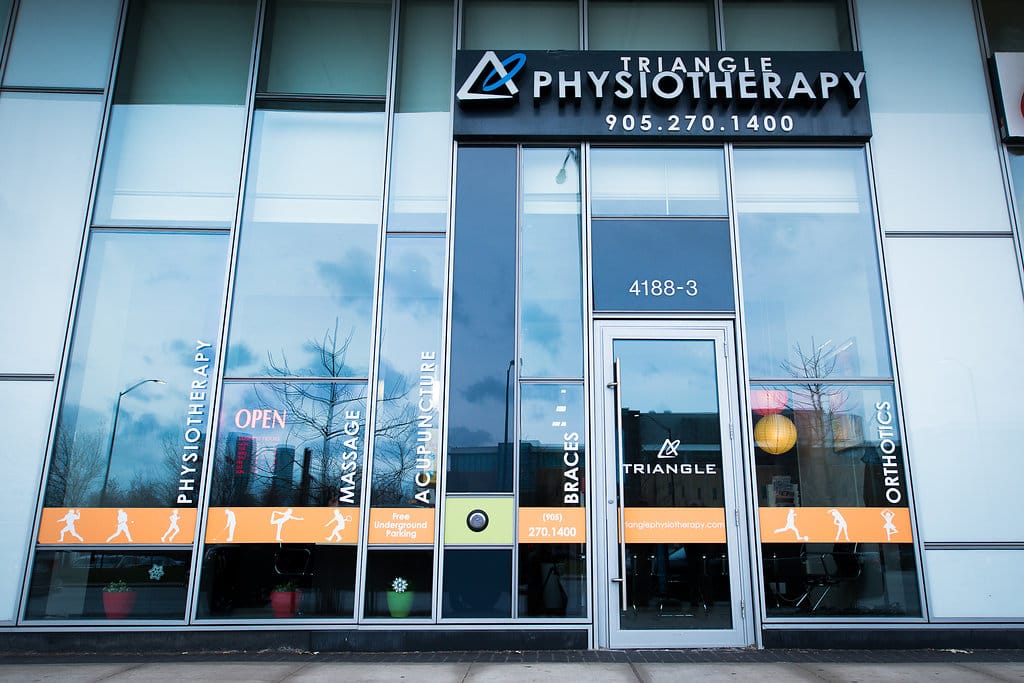

When looking for physiotherapy in Mississauga, it’s essential to find a qualified and experienced physiotherapist who specializes in pregnancy and pelvic health. Our Locations in Mississauga have trained and experienced pelvic health physiotherapists with advanced training in pelvic health including Labour and Delivery Prep.
Pregnancy back pain is a common but manageable condition. With the right approach, such as physiotherapy in Mississauga, expecting mothers can find relief and improve their overall well-being. Pelvic health physiotherapists at Triangle Physiotherapy in Mississauga offers specialized care that addresses the unique challenges of pregnancy, providing a holistic approach to pain management and preparation for childbirth. By incorporating physiotherapy into their prenatal care routine, pregnant women can enjoy a more comfortable and healthy pregnancy journey.
Triangle Physiotherapy has 2 locations in Mississauga to help you with your pregnancy-related back pain:
Triangle Physiotherapy Square One
Triangle Physiotherapy Erin Mills
“At Triangle Physiotherapy, we have multiple locations across the GTA, including Physiotherapy in Etobicoke, Oakville, North York, Toronto, Lawrence Park, Queens Quay, Erin Mills, Mississauga, and Liberty Village. Our clinics are dedicated to providing specialized care for pregnancy-related back pain, ensuring that every expecting mother receives the best possible treatment.”
Vaginal atrophy, also known as atrophic vaginitis, is a condition that many women experience, especially after menopause. It involves changes in the vaginal area that can cause discomfort and other symptoms. Fortunately, our pelvic health physiotherapists in North York can help manage these symptoms and improve your quality of life.
What is Vaginal Atrophy?
Vaginal atrophy often happens during menopause when the levels of estrogen, a hormone in a woman’s body, decrease. When this happens, it can lead to:
- Dryness: The vagina becomes less moist, leading to dryness and irritation.
- Thinning of Vaginal Walls: The walls of the vagina become thinner and less flexible.
- Inflammation and Redness: The vaginal area can become inflamed and red, causing pain.
- Urinary Symptoms: You might experience more frequent urination, a strong urge to urinate, or urinary tract infections (UTIs).
These changes can make everyday activities uncomfortable and affect your sex life.
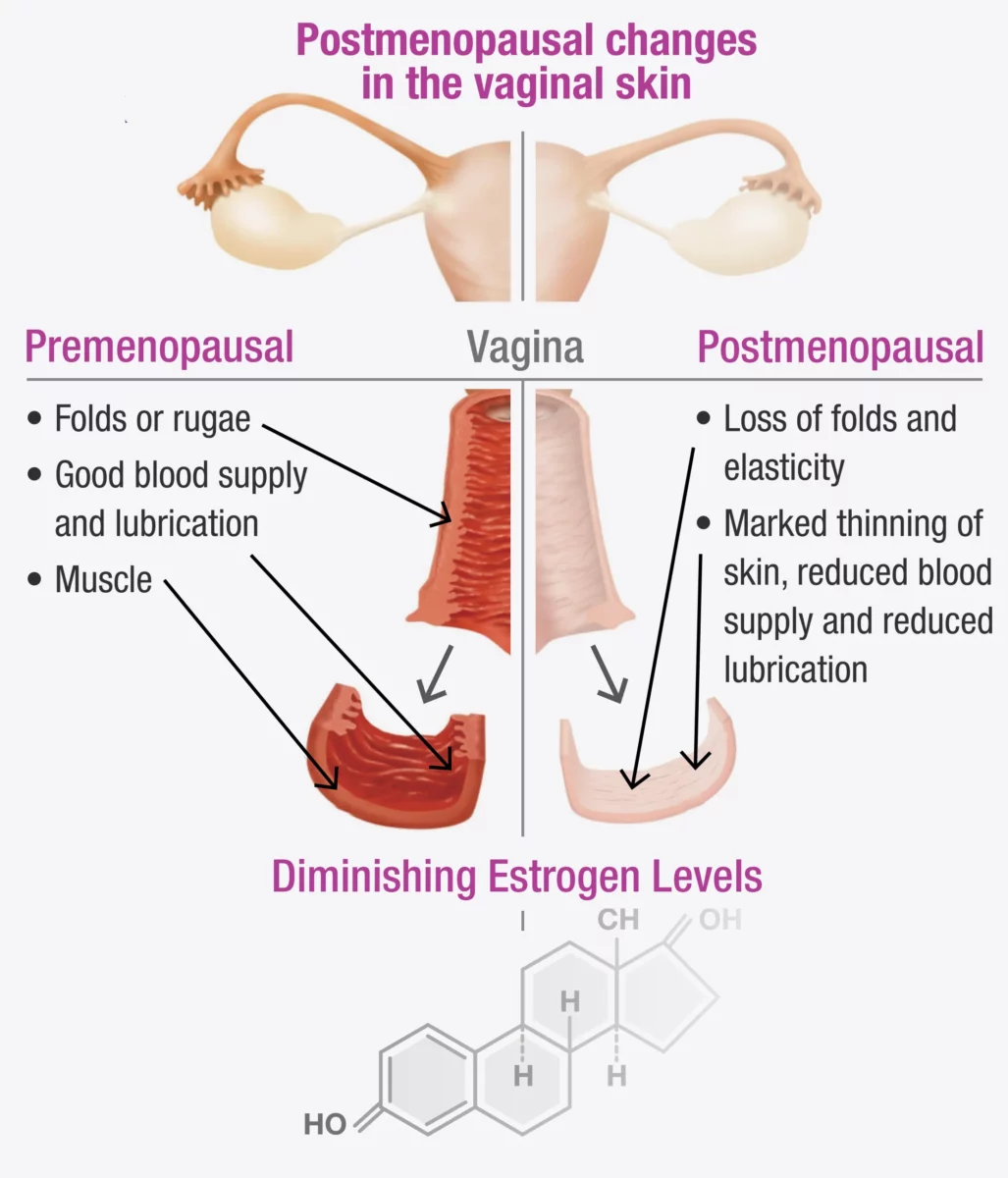
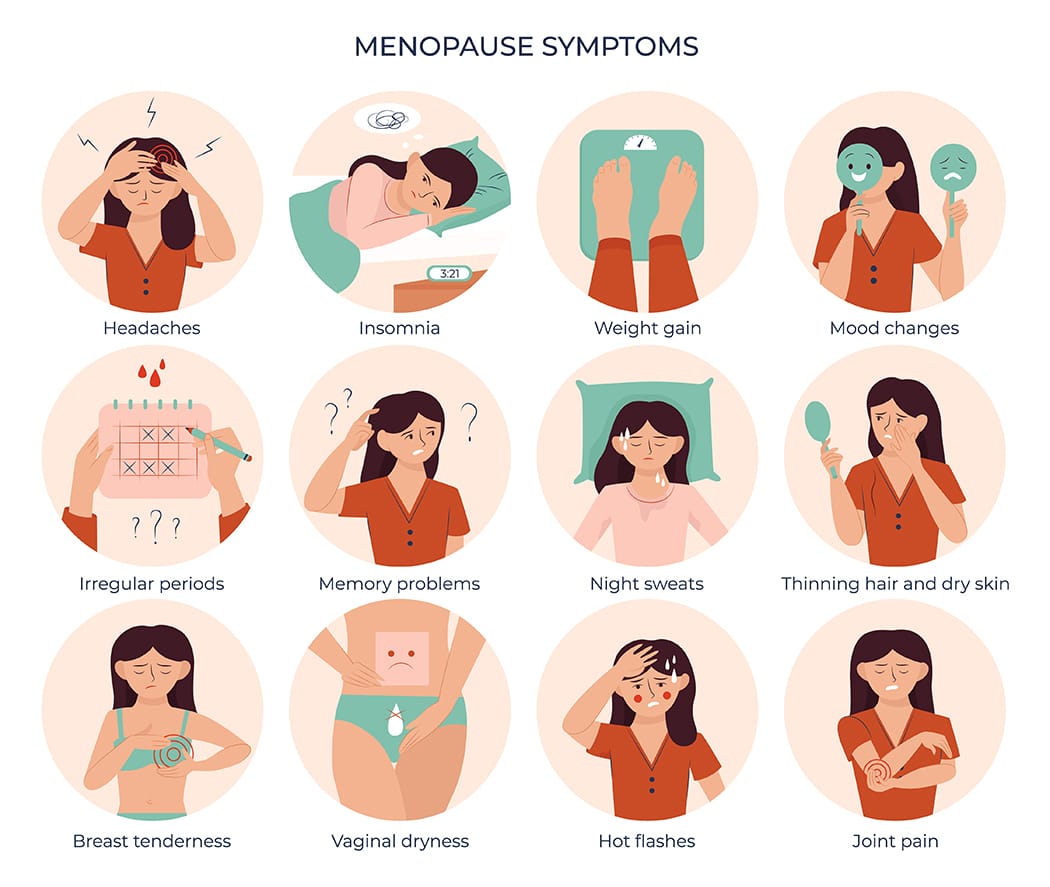
If vaginal atrophy is not treated and a woman continues to experience painful intercourse, the vaginal muscles may react by tightening to protect the body. Over time, this tightening can become an automatic response (vaginismus) that continues even after the atrophy has been treated.
Fortunately, both conditions can be treated with the help of a pelvic health Physiotherapist in North York. In fact, it is often necessary to treat vaginal atrophy and vaginismus together, as addressing one without the other can be challenging.
Symptoms to Watch For
You might have vaginal atrophy if you notice:
- Pain During Sex: Painful intercourse (called dyspareunia) is a common symptom.
- Itching or Burning: These sensations can be uncomfortable and persistent.
- Frequent UTIs: More urinary tract infections than usual.
- Vaginal Bleeding or Discharge: Unusual bleeding or discharge can occur.
- Difficulty Urinating: Problems with urination, such as a strong urge or pain.
Recognizing these symptoms early can help you get the treatment you need sooner.
How a Pelvic Health Physiotherapist Can Help with Menopause and Vaginal Atrophy
A pelvic health physiotherapist is a specialist who focuses on the muscles and tissues in the pelvic area. They can provide various treatments to help manage vaginal atrophy. Here’s how they can assist:
1. Assessment and Diagnosis
The first step is a thorough check-up, which includes:
- Reviewing Your Medical History: Discussing your symptoms, medical history, and any medications you are taking.
- Physical Examination: Checking the condition of your vaginal walls, pelvic floor muscles, and surrounding tissues.
2. Customized Exercise Programs
These physiotherapists create specific exercise programs to strengthen and relax your pelvic floor muscles. These exercises can:
- Improve Muscle Tone: Making the vaginal muscles stronger and more flexible.
- Boost Blood Flow: Increasing circulation to help with healing and tissue health.
3. Manual Therapy and Techniques
Hands-on techniques are used to improve the flexibility and function of your pelvic area, such as:
- Myofascial Release: Reducing tension in the pelvic muscles.
- Scar Tissue Mobilization: Addressing any scarring or adhesions in the vaginal area.
4. Education and Lifestyle Advice for Menopause
Education is a key part of therapy, including advice on:
- Diet and Hydration: Eating a balanced diet and staying hydrated for overall health.
- Relaxation Techniques: Learning how to relax your pelvic floor muscles to reduce discomfort.
5. Use of Devices and Modalities
They might suggest using certain devices and techniques, such as:
- Vaginal Dilators: These help gently stretch the vaginal walls, making them more flexible.
- Electrostimulation: Using mild electrical impulses to strengthen pelvic muscles.
How do I find a pelvic health physiotherapist in North York?
We have 8 locations with pelvic health physiotherapists to help you. If you are going through menopause and are seeing signs of vaginal atrophy, Book an Appointment today!
Pelvic Health Physiotherapists in North York:
- Pelvic Health Physiotherapy North York – Triangle Physiotherapy North York
- Uptown Toronto Pelvic Health – Triangle Physiotherapy Lawrence Park
At Triangle Physiotherapy, we understand that conditions like menopause and vaginal atrophy can significantly impact your quality of life. Our team of experienced professionals is here to help you through specialized physiotherapy treatments designed to address these and other related concerns. Whether you’re seeking Physiotherapy in Etobicoke, Physiotherapy in Oakville, Physiotherapy in North York, or Physiotherapy in Toronto, we have clinics conveniently located across the region. Visit us at Physiotherapy Lawrence Park, Physiotherapy Clinic Queens Quay, Physiotherapy Erin Mills, Physiotherapy Mississauga, or Physiotherapy Liberty Village to start your journey towards better health and well-being.
An episiotomy is a surgical incision made in the perineum (the patch of skin between the vaginal opening and the anus) during childbirth, is a common procedure to aid in a smoother delivery. Despite its benefits, an episiotomy can lead to discomfort, pain, and complications in postpartum recovery. This blog explores how a pelvic health physiotherapist can play a crucial role in managing and alleviating post-episiotomy issues, ensuring a healthier recovery for new mothers.
Our trained and experienced Pelvic Health Physiotherapists in Mississauga can make a significant difference to your recovery after child-birth.

Why is an episiotomy performed during delivery?
An episiotomy may be performed by the obstetrician during delivery for various reasons:
1. Prevent Severe Tearing
2. Facilitate a Faster Delivery
In situations where a rapid delivery is required for the safety of the baby or mother, an episiotomy can speed up the process. This is particularly crucial in cases of:
- Fetal Distress: If the baby shows signs of distress, such as an abnormal heart rate, a quick delivery becomes essential. An episiotomy can help expedite the birth, reducing the risk of complications for the baby.
- Prolonged Labor: When labor is not progressing, and the baby is not moving down the birth canal as expected, an episiotomy can aid in accelerating the delivery.
3. Assisted Deliveries
Episiotomies are more commonly performed during assisted deliveries involving instruments like forceps or vacuum extractors.
4. Shoulder Dystocia
Shoulder dystocia occurs when the baby’s shoulder becomes lodged behind the mother’s pelvic bone during delivery. This can be a critical situation requiring immediate intervention. An episiotomy can provide additional room for the baby’s shoulder to be maneuvered and delivered safely.
5. Large Baby
When a baby is larger than average, delivering them vaginally can be challenging. An episiotomy may be performed to create more space, reducing the risk of severe tearing and facilitating a smoother delivery.
6. Previous Pelvic Surgery or Scarring
What is the role of a pelvic health physiotherapist in recovering from an Episiotomy?
A pelvic health physiotherapist specializes in the rehabilitation of pelvic floor muscles. They are trained to address issues related to childbirth, including those arising from an episiotomy. At Triangle Physiotherapy Mississauga, our pelvic health physiotherapists are highly trained in helping new mothers navigate their post-partum recovery.
- Pain Management and Scar Tissue Mobilization
- Pelvic Floor Rehabilitation
- Bladder and Bowel Function Improvement
- Addressing Incontinence: Many women experience urinary or fecal incontinence after an episiotomy. Pelvic health physiotherapists can help manage these issues through targeted exercises and lifestyle modifications.
- Diet and Hydration Advice: Proper diet and hydration are essential for optimal bladder and bowel function. Physiotherapists offer valuable advice on nutrition that supports recovery.
- Posture and Mobility
- Improving Posture: Poor posture can exacerbate pelvic pain. Physiotherapists help new mothers correct their posture, reducing strain on the pelvic floor and aiding in overall recovery.
- Safe Return to Activity: Guiding new mothers on safely returning to physical activities is vital. Physiotherapists create gradual exercise plans to ensure a safe and effective return to daily activities and fitness routines.
- Emotional Support and Counseling
- Addressing Psychological Aspects: The postpartum period can be emotionally challenging. Physiotherapists provide emotional support and can refer patients to mental health professionals if needed, ensuring a holistic approach to recovery.
- Building Confidence: Encouraging words and positive reinforcement from physiotherapists can boost new mothers’ confidence in their recovery journey.
If you have had an episiotomy during delivery, contact us to book an appointment to see one of our pelvic health physiotherapists in Mississauga to get started on the road to recovery.
Where can I find a pelvic health physiotherapist in Mississauga?
We have 2 convenient locations in Mississauga that offer pelvic health:
Mississauga Pelvic Health – Triangle Physiotherapy Mississauga
Mississauga Pelvic Health – Triangle Physiotherapy Erin Mills
“Recovering from an episiotomy can be challenging, but with the help of a pelvic health physiotherapist, you can regain your strength and confidence. Triangle Physiotherapy offers specialized care at multiple locations across the GTA, including Physiotherapy in Etobicoke, Oakville, North York, Toronto, Lawrence Park, Queens Quay, Erin Mills, Mississauga, and Liberty Village. Our experienced team is here to support you every step of the way.”
Pelvic Health – Menstrual cups and menstrual discs are reusable feminine hygiene products designed to collect menstrual fluid.

What is a Menstrual Cup?
Menstrual cups are generally crafted from silicone or rubber.
Unlike tampons, which absorb blood, these cups collect it, reducing the risk of infection.
One advantage of the menstrual cup is its larger capacity compared to a tampon’s absorbency, allowing for less frequent changes. Most cups can be worn for up to 12 hours, depending on your flow.
What is a Menstrual Disc?
Unlike menstrual cups, menstrual discs sit higher in the vaginal canal, tucked behind the pubic bone. Here are some key features and benefits of menstrual discs:
- Design and Use:
- Shape: Menstrual discs are flat and round, resembling a small diaphragm, with a flexible rim and a thin, flexible body.
- Insertion: The disc is pinched and inserted into the vagina, where it is positioned horizontally and covers the cervix.
- Capacity: Like menstrual cups, discs can hold a significant amount of fluid and can be worn for up to 12 hours.
What are the benefits of a Menstrual Cup?
Benefits:
- Cost-Effective: While the initial purchase price may be higher than disposable products, menstrual cups can be reused for several years, saving money over time.
- Eco-Friendly: Reusable nature reduces waste compared to disposable tampons and pads.
- Health: Made from medical-grade materials that are safe and reduce the risk of Toxic Shock Syndrome (TSS) associated with tampons.
What are the benefits of a Menstrual Disc?
Benefits:
- Comfort: Positioned differently than cups, discs can be more comfortable for some users, especially during physical activities or sex.
- Mess-Free Intercourse: Many menstrual discs can be worn during intercourse without obstructing the vaginal canal, offering a mess-free experience.
- Eco-Friendly: Reusable menstrual discs reduce waste compared to disposable products. However, there are also single-use disposable options available.
Using a Menstrual Cup Vs. a Menstrual Disc
Using a menstrual cup involves a few steps to ensure proper insertion, positioning, and removal. Here’s a detailed guide on how to use a menstrual cup:Insertion
Wash Your Hands:
- C-fold: Press the sides of the cup together and then fold it in half to form a “C” shape.Punch-down fold: Push the rim of the cup down into the base, creating a narrower point for insertion.
Duration:
Wash Your Hands:
Sterilization:
Using a menstrual disc involves a few steps to ensure proper insertion, positioning, and removal. Here is a detailed guide on how to use a menstrual disc:Insertion
Wash Your Hands:
Duration:
Wash Your Hands:
Sterilization:
Menstrual discs and cups are both effective options for period management. Choose the one that suits you best based on factors like comfort, lifestyle, and size preference. Ultimately, neither a disc nor a cup might be the right choice for you, but they are both excellent alternatives to tampons for those seeking different options.
Our More Locations
Physiotherapy Etobicoke | Physiotherapy Oakville | Physiotherapy North York | Physiotherapy Toronto | Physiotherapy Lawrence Park | Physiotherapy Mississauga | Physiotherapy Queens Quay | Physiotherapy Mississauga Erin Mills | Physiotherapy Liberty Village
Where can I find a pelvic health physiotherapist in Mississauga?
We have 8 locations with pelvic health physiotherapists to help you.
- Pelvic Health Physiotherapy Etobicoke – Triangle Physiotherapy Etobicoke
- Oakville Pelvic Health – Triangle Physiotherapy Oakville
- Pelvic Health Physiotherapy North York – Triangle Physiotherapy North York
- Mississauga Pelvic Health – Triangle Physiotherapy Mississauga
- Downtown Pelvic Health – Triangle Physiotherapy King West
- Uptown Toronto Pelvic Health – Triangle Physiotherapy Lawrence Park
- Pelvic Physiotherapy Downtown Toronto – Triangle Physiotherapy Queens Quay
- Mississauga Pelvic Health – Triangle Physiotherapy Erin Mills
Choosing between a menstrual cup and a menstrual disc can depend on individual comfort and pelvic health needs. For expert advice on pelvic health and guidance on using these products, consider physiotherapy in Etobicoke, Oakville, North York, Toronto, Lawrence Park, Queens Quay, Erin Mills, Mississauga, or Liberty Village. Experienced physiotherapists in these locations can provide personalized care and support for all your pelvic health concerns.

